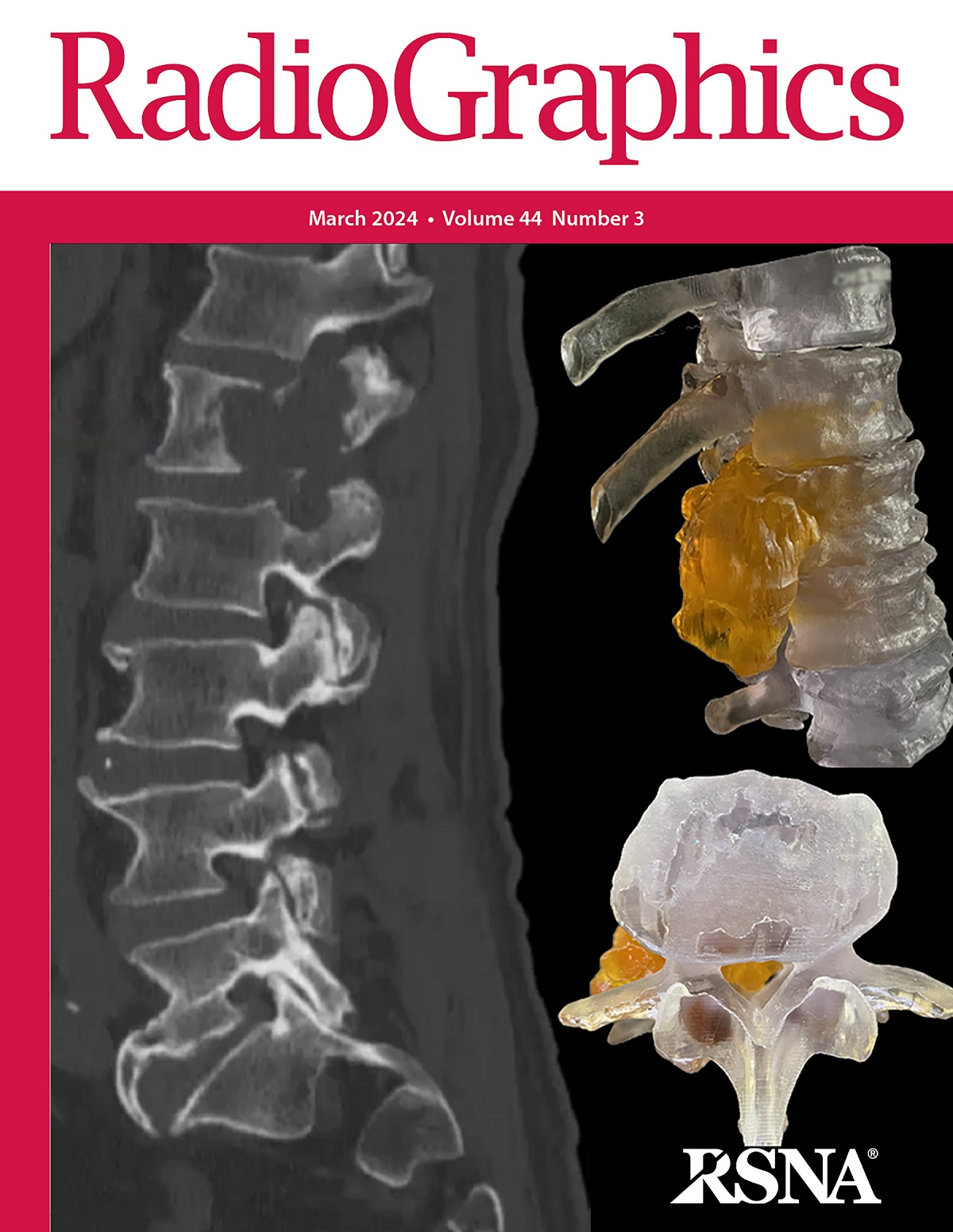下载PDF
{"title":"心律失常性心肌病的影像特征。","authors":"Mauricio S Galizia, Anil K Attili, William R Truesdell, Eric D Smith, Adam S Helms, Abdulbaset M A Sulaiman, Chaitanya Madamanchi, Prachi P Agarwal","doi":"10.1148/rg.230154","DOIUrl":null,"url":null,"abstract":"<p><p>Arrhythmogenic cardiomyopathy (ACM) is a genetic disease characterized by replacement of ventricular myocardium with fibrofatty tissue, predisposing the patient to ventricular arrhythmias and/or sudden cardiac death. Most cases of ACM are associated with pathogenic variants in genes that encode desmosomal proteins, an important cell-to-cell adhesion complex present in both the heart and skin tissue. Although ACM was first described as a disease predominantly of the right ventricle, it is now acknowledged that it can also primarily involve the left ventricle or both ventricles. The original right-dominant phenotype is traditionally diagnosed using the 2010 task force criteria, a multifactorial algorithm divided into major and minor criteria consisting of structural criteria based on two-dimensional echocardiographic, cardiac MRI, or right ventricular angiographic findings; tissue characterization based on endomyocardial biopsy results; repolarization and depolarization abnormalities based on electrocardiographic findings; arrhythmic features; and family history. Shortfalls in the task force criteria due to the modern understanding of the disease have led to development of the Padua criteria, which include updated criteria for diagnosis of the right-dominant phenotype and new criteria for diagnosis of the left-predominant and biventricular phenotypes. In addition to incorporating cardiac MRI findings of ventricular dilatation, systolic dysfunction, and regional wall motion abnormalities, the new Padua criteria emphasize late gadolinium enhancement at cardiac MRI as a key feature in diagnosis and imaging-based tissue characterization. Conditions to consider in the differential diagnosis of the right-dominant phenotype include various other causes of right ventricular dilatation such as left-to-right shunts and variants of normal right ventricular anatomy that can be misinterpreted as abnormalities. The left-dominant phenotype can mimic myocarditis at imaging and clinical examination. Additional considerations for the differential diagnosis of ACM, particularly for the left-dominant phenotype, include sarcoidosis and dilated cardiomyopathy. <sup>©</sup>RSNA, 2024 Test Your Knowledge questions for this article are available in the supplemental material.</p>","PeriodicalId":54512,"journal":{"name":"Radiographics","volume":"44 4","pages":"e230154"},"PeriodicalIF":5.2000,"publicationDate":"2024-04-01","publicationTypes":"Journal Article","fieldsOfStudy":null,"isOpenAccess":false,"openAccessPdf":"https://www.ncbi.nlm.nih.gov/pmc/articles/PMC10995833/pdf/","citationCount":"0","resultStr":"{\"title\":\"Imaging Features of Arrhythmogenic Cardiomyopathies.\",\"authors\":\"Mauricio S Galizia, Anil K Attili, William R Truesdell, Eric D Smith, Adam S Helms, Abdulbaset M A Sulaiman, Chaitanya Madamanchi, Prachi P Agarwal\",\"doi\":\"10.1148/rg.230154\",\"DOIUrl\":null,\"url\":null,\"abstract\":\"<p><p>Arrhythmogenic cardiomyopathy (ACM) is a genetic disease characterized by replacement of ventricular myocardium with fibrofatty tissue, predisposing the patient to ventricular arrhythmias and/or sudden cardiac death. Most cases of ACM are associated with pathogenic variants in genes that encode desmosomal proteins, an important cell-to-cell adhesion complex present in both the heart and skin tissue. Although ACM was first described as a disease predominantly of the right ventricle, it is now acknowledged that it can also primarily involve the left ventricle or both ventricles. The original right-dominant phenotype is traditionally diagnosed using the 2010 task force criteria, a multifactorial algorithm divided into major and minor criteria consisting of structural criteria based on two-dimensional echocardiographic, cardiac MRI, or right ventricular angiographic findings; tissue characterization based on endomyocardial biopsy results; repolarization and depolarization abnormalities based on electrocardiographic findings; arrhythmic features; and family history. Shortfalls in the task force criteria due to the modern understanding of the disease have led to development of the Padua criteria, which include updated criteria for diagnosis of the right-dominant phenotype and new criteria for diagnosis of the left-predominant and biventricular phenotypes. In addition to incorporating cardiac MRI findings of ventricular dilatation, systolic dysfunction, and regional wall motion abnormalities, the new Padua criteria emphasize late gadolinium enhancement at cardiac MRI as a key feature in diagnosis and imaging-based tissue characterization. Conditions to consider in the differential diagnosis of the right-dominant phenotype include various other causes of right ventricular dilatation such as left-to-right shunts and variants of normal right ventricular anatomy that can be misinterpreted as abnormalities. The left-dominant phenotype can mimic myocarditis at imaging and clinical examination. Additional considerations for the differential diagnosis of ACM, particularly for the left-dominant phenotype, include sarcoidosis and dilated cardiomyopathy. <sup>©</sup>RSNA, 2024 Test Your Knowledge questions for this article are available in the supplemental material.</p>\",\"PeriodicalId\":54512,\"journal\":{\"name\":\"Radiographics\",\"volume\":\"44 4\",\"pages\":\"e230154\"},\"PeriodicalIF\":5.2000,\"publicationDate\":\"2024-04-01\",\"publicationTypes\":\"Journal Article\",\"fieldsOfStudy\":null,\"isOpenAccess\":false,\"openAccessPdf\":\"https://www.ncbi.nlm.nih.gov/pmc/articles/PMC10995833/pdf/\",\"citationCount\":\"0\",\"resultStr\":null,\"platform\":\"Semanticscholar\",\"paperid\":null,\"PeriodicalName\":\"Radiographics\",\"FirstCategoryId\":\"88\",\"ListUrlMain\":\"https://doi.org/10.1148/rg.230154\",\"RegionNum\":1,\"RegionCategory\":\"医学\",\"ArticlePicture\":[],\"TitleCN\":null,\"AbstractTextCN\":null,\"PMCID\":null,\"EPubDate\":\"\",\"PubModel\":\"\",\"JCR\":\"Q1\",\"JCRName\":\"RADIOLOGY, NUCLEAR MEDICINE & MEDICAL IMAGING\",\"Score\":null,\"Total\":0}","platform":"Semanticscholar","paperid":null,"PeriodicalName":"Radiographics","FirstCategoryId":"88","ListUrlMain":"https://doi.org/10.1148/rg.230154","RegionNum":1,"RegionCategory":"医学","ArticlePicture":[],"TitleCN":null,"AbstractTextCN":null,"PMCID":null,"EPubDate":"","PubModel":"","JCR":"Q1","JCRName":"RADIOLOGY, NUCLEAR MEDICINE & MEDICAL IMAGING","Score":null,"Total":0}
引用次数: 0
引用
批量引用


